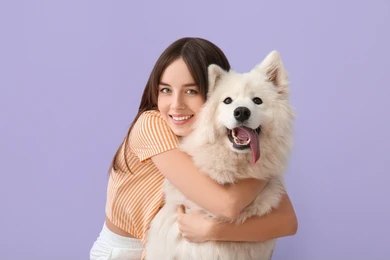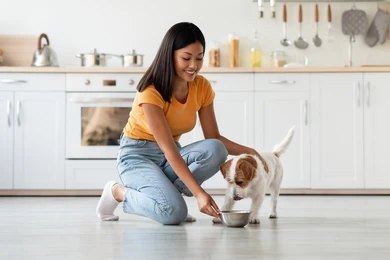Your dog is naturally curious and eager to learn, and from a young age, they have been gathering important life skills from their surroundings. Their interactions with other dogs and people have taught them basic social behaviors, such as how to communicate through body language and respond to subtle cues.
When you bring your dog into a new environment, they may feel a bit anxious or uncertain. This is the real time to establish their natural learning abilities by building clear boundaries and routines. With patience and consistency, you can groom them toward becoming a well-adapted and happy companion.

Let's Begin!
Before beginning any training with your dog, it’s essential to establish a consistent system of communication. Choose one “praise” word and one “release” word that everyone in your household will use consistently. The praise word signals correct behavior and might be something like “good,” “yes,” or “clever.” The release word lets your dog know when a behavior is complete and they are free, with examples being “okay,” “enough,” or “done.” It’s vital that these words sound distinct from one another to avoid confusion.
When teaching a command like “sit,” use the praise word the moment your dog successfully performs the action, followed by the release word to indicate that they can move again. Without a clear release word, your dog might assume on their own when it’s acceptable to stop the behavior, which can lead to inconsistencies in learning.
Having small, soft treats on hand, such as bits of cooked chicken or cheese, can be a valuable tool for promptly rewarding good behavior. Remember to factor these treats into your dog’s daily food allowance to avoid overfeeding.
House-training should begin the moment you bring your dog home. Take your pup to the designated potty area immediately and lavishly praise them if they use it. Repeat this routine after every meal, after naps, after playtime, and whenever you notice them sniffing or circling. Consistency is key, so always use the same area and provide enthusiastic praise when they succeed. This helps your dog quickly understand what you expect and builds a solid foundation for training.
The Basics
The first thing your dog needs to learn is their name. Use their name often to grab their attention. When they respond by looking at you, offer praise, pet them, or engage in a quick play session. During mealtime, call their name and add the word “come” as you place their bowl down, even if they’re already next to you. This repetition helps your dog associate their name with positive interactions and commands.
By pairing the word “come” with feeding time, your dog will quickly learn to associate it with something rewarding. This early training creates a strong foundation for reliable recall later on. If your dog comes toward you on their own, call their name and say “come,” then reward them with a treat. You can also use a small plastic container filled with dried beans to create a rattling sound, call their name and “come,” and reward their curiosity when they approach. Over time, as your dog’s response improves, you can phase out the rattle.
Always ensure that coming to you is a positive experience. Never call your dog to you for scolding, nail trimming, bathing, or other activities they might find unpleasant. This maintains their trust and ensures a reliable recall response. For more detailed guidance on teaching recall, you can explore additional resources on the topic.

Good Early Commands
Teaching your dog commands like “sit” and “down” can start early since these are natural behaviors for them. However, your dog doesn’t know what these words mean yet, so they need to learn through association. Imagine if someone said “blip” to you—it wouldn’t mean anything at first. But if they said “blip” every time you stood up and handed you a reward, you’d soon figure it out!
To teach “sit,” watch for moments when your puppy is about to sit naturally. As their bottom touches the ground, say “sit,” then praise them with “good sit” and offer a treat. For training, hold a treat slightly above their nose and move it back over their head. As their nose follows the treat, their bottom should lower. Say “sit” just as they sit, praise with “good sit,” and reward with a treat. If your puppy backs up instead of sitting, practice near a wall or apply gentle pressure on their back to guide them. Once they understand “sit,” use the command regularly, like before meals, to reinforce the behavior.
For “down,” take advantage of moments when your puppy lies down naturally. Say “down” as they do it, praise with “good down,” and reward. To teach the command, start with your puppy in a sit. Hold a treat in your hand and lower it straight to the ground from their nose. Slide your hand out along the floor to form an “L” shape, encouraging their front legs to follow. If needed, apply gentle pressure on their shoulders, but avoid pulling their legs. When they lie down, say “down,” praise with “good down,” and reward.
Consistent practice and positive reinforcement will help your dog understand and respond to these commands reliably.
On A Roll Now
Teaching your dog to focus on you is a foundational skill for effective training. Start by sitting down at their level to make eye contact easier. Take a treat in your fingers and let your dog see it. Slowly raise the treat to your eye level and say, “watch.” The moment they make eye contact, praise them and offer the treat. Practice this throughout the day, gradually increasing the duration of eye contact to build their focus.
Introducing “stay” or “wait” can also begin early, but keep in mind that puppies have short attention spans. Once your dog understands “sit” or “down,” you can add “wait.” Place your puppy in the desired position, give a clear hand signal along with the command “wait,” then take a small step in front of them. Remind them to wait, step back beside them, praise with “good wait,” and reward. Be sure to release them only after they’ve received the reward so they associate the reward with staying in place, not moving. Slowly increase the time before the distance when extending the exercise, and always keep expectations realistic to avoid frustration.
The “give” command is also incredibly useful for safety and practicality. Puppies love picking up items, from toys to unsafe objects. Teach “give” by trading the object in their mouth for a treat. Say “give” as you offer the trade, and reward them when they release the item. Practice frequently by swapping toys or trading a toy for a treat. Always return the toy after they’ve handed it over and been rewarded. Avoid chasing your puppy to retrieve items, as they’ll think it’s a game and run away faster. Consistent practice of this command will help ensure your dog willingly gives up items, making your life easier and keeping them safe.

Getting Used To The Collar And Lead
Although your puppy cannot go for walks in public until fully vaccinated, you can start training with a collar and lead indoors or in your garden. Begin with a soft, lightweight collar and lead. Put the collar on for a few minutes at first, gradually increasing the time. It’s normal for puppies to scratch at the collar initially, but they’ll adapt as they wear it more often. Putting the collar on during meals can distract them and help them adjust quickly.
Next, introduce the lead. Attach it to the collar and let the puppy move around while you follow, holding the lead loosely. Once comfortable, encourage them to follow you by luring with a treat and praising them when they come toward you. Always use treats and positive reinforcement to keep the experience enjoyable. Avoid dragging or pulling the puppy, as this can cause them to become lead-shy.
Keep training sessions short and fun, ending with a game they enjoy. For puppies resistant to the lead, walking them to their food bowl at mealtimes can help them adjust. To prevent pulling, use your voice and treats to encourage your puppy to stay close by your side. When they walk beside you on a loose lead, praise with “close, good close,” and offer rewards. Early training will make walking on the lead enjoyable and much easier when your puppy is ready for formal walks.
Length Of Training Sessions
Puppies have short attention spans, so training sessions should be brief and frequent—just a few minutes several times a day rather than longer, infrequent sessions. It’s best to train before mealtimes when your puppy is a bit hungry and more motivated to work for treats, rather than after a meal when they may feel sleepy and uninterested. Always set your puppy up for success. Avoid asking for a “sit,” “come,” or “down” if they are too distracted to focus.
Only correct mistakes if you’re certain your puppy understands the command but is choosing not to comply. Consistency is crucial—everyone in the household should use the same commands, praise words, and release cues. If one person says “drop” and another says “down” for the same action, it can confuse the puppy.
Don’t train a tired puppy or attempt to teach if you’re feeling frustrated or in a negative mood. A calm and positive approach ensures that training is effective and enjoyable for both you and your puppy.





